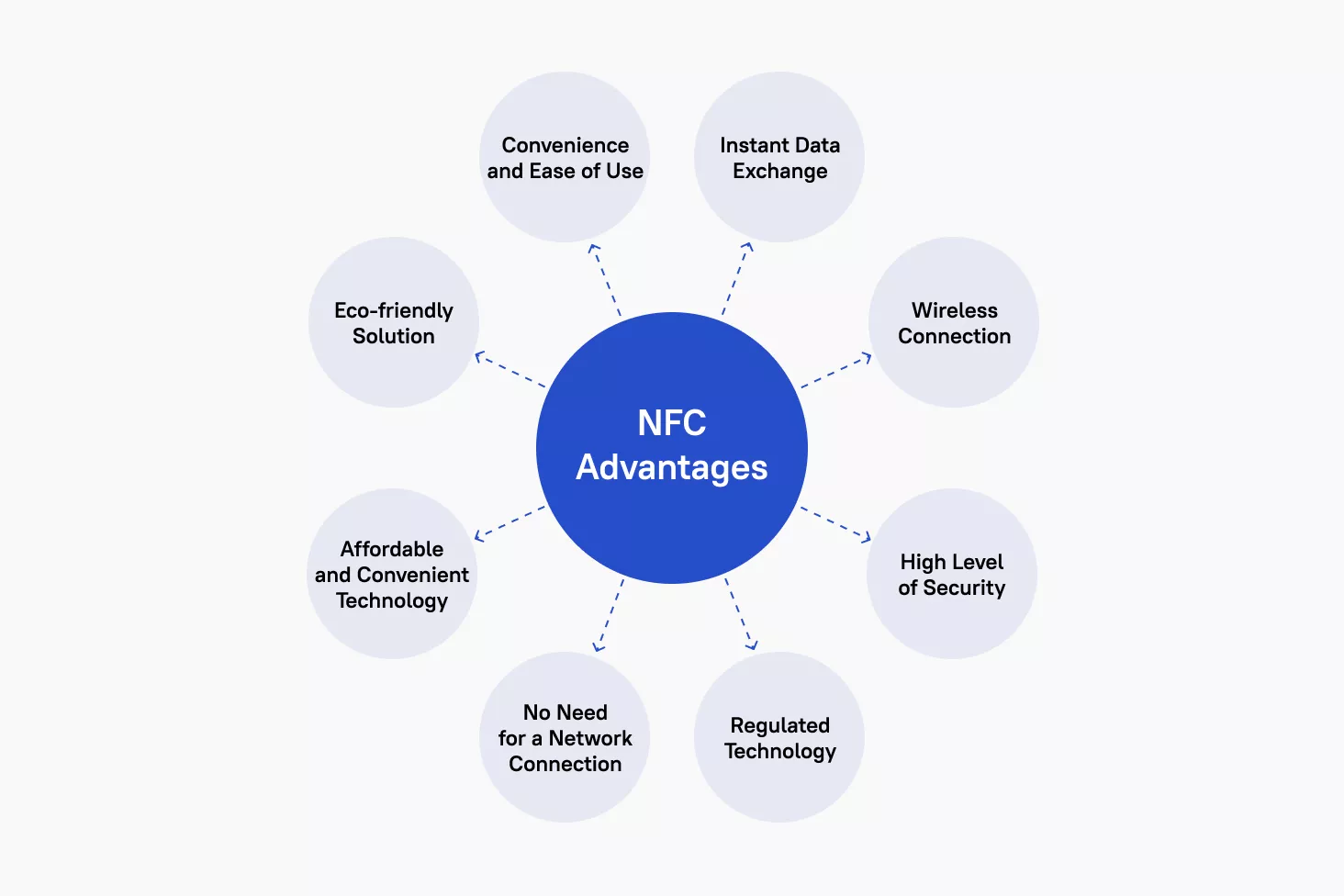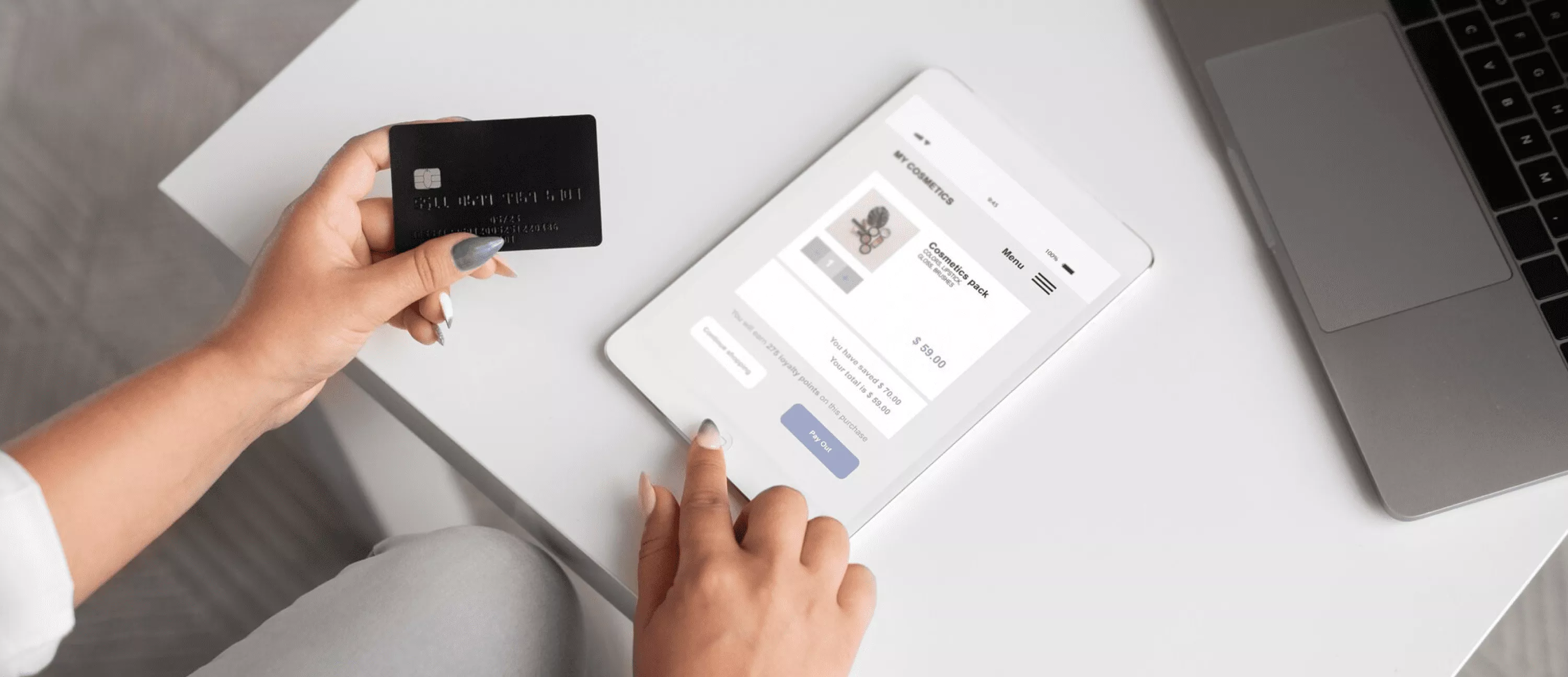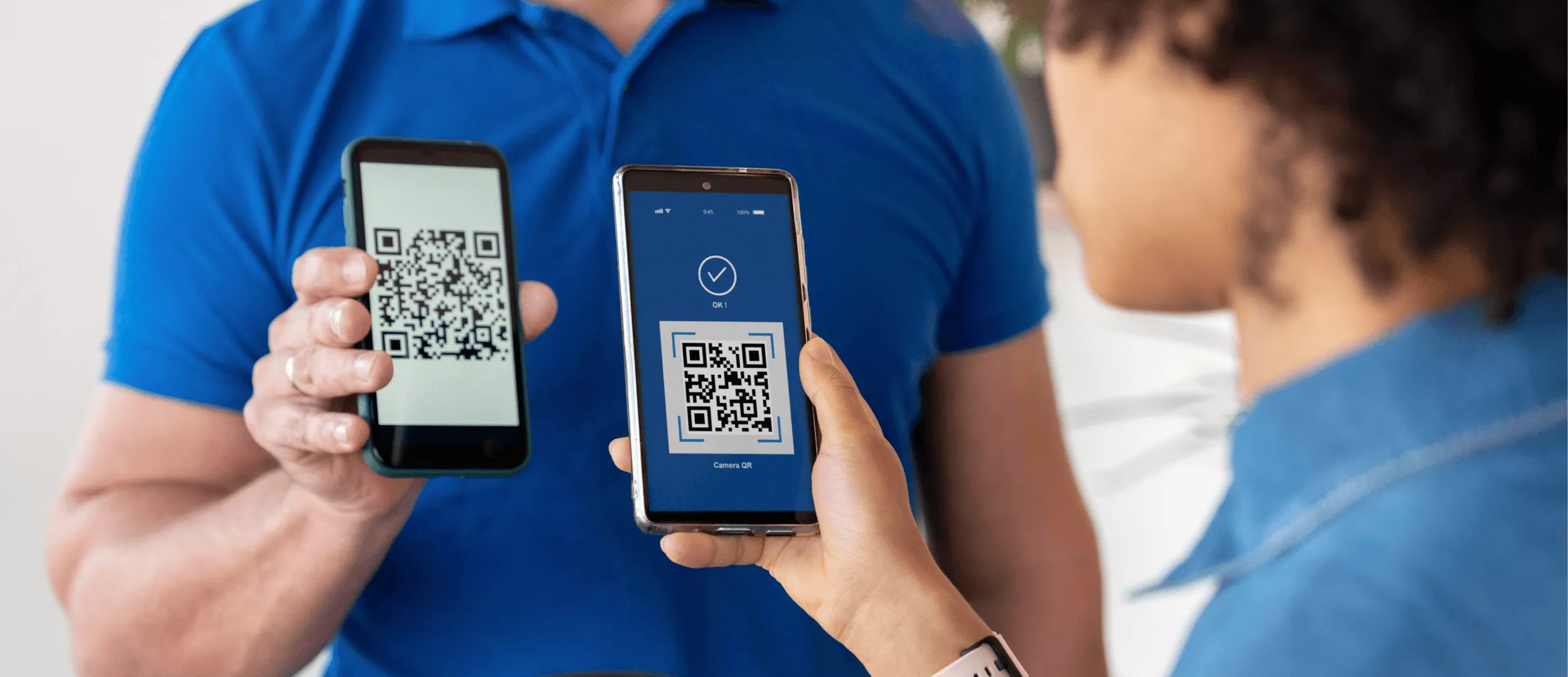
Останніми роками технологія NFC активно використовується в різних сферах нашого життя. Ви, можливо, навіть не підозрюєте, що є активним користувачем. Мова йде про технологію NFC, за допомогою якої ви можете оплачувати покупки в магазині телефоном. Але її можливості не обмежуються цим.
NFC та NFT роблять можливим надання кожному фізичному об'єкту ексклюзивного ідентифікатора в блокчейні.
Використання як NFC-міток, так і їхньої вродженої двосторонності забезпечує плавний перехід вартості об'єкта в метавсесвіт, забезпечуючи надійний захист від підробок. Використовуючи технологічну ДНК, яку надають додатки NFC+NFT у творах мистецтва та не лише, можна уникнути будь-яких можливих спроб підробки.
Що таке NFC-мітки?
NFC є частиною радіочастотної ідентифікації (RFID) і частиною Bluetooth. NFC-мітки працюють лише на близькій відстані для більшої точності, на відміну від RFID. Це не вимагає ручної синхронізації пристроїв, як Bluetooth. RFID-мітка має лише односторонній спосіб зв'язку, тому елемент з RFID надсилає сигнал до RFID-читача.
Плануєте запуск цифрового продукту?
Розробляємо стабільні та масштабовані веб- і мобільні застосунки для бізнесу.
Аліна
Клієнт-менеджер

Пристрої NFC мають односторонні та двосторонні способи зв'язку, що надає технології NFC перевагу в ситуаціях, де транзакції залежать від даних з двох пристроїв. Мобільні гаманці, такі як Samsung Pay, Android Pay, Apple Pay та інші, всі включають технологію NFC.
NFS-мітки розширюють функціональність гаджетів, контактуя з іншими пристроями на максимальній відстані 3.9’. Обмін файлами, управління електронними платежами, підключення побутової техніки - тепер усе це робиться одним дотиком. Крім того, використання таких міток захистить файли та інформацію від перехоплення зловмисними пристроями.
Що таке зв'язок на близькій відстані
Абревіатура NFC означає зв'язок на близькій відстані. Це технологія бездротової передачі даних на короткій відстані: радіус зв'язку не перевищує 3.9’. Інформація з об'єктів зчитується за допомогою радіосигналу.
Основні переваги технології NFC:
- висока швидкість встановлення з'єднання між об'єктами (процес займає частку секунди);
- малий розмір пристрою;
- низьке споживання енергії.
Завдяки цим функціям NFC-мітки можуть бути інтегровані в малі гаджети. Слід зазначити, що швидкість передачі інформації через цей комунікаційний протокол відносно низька, а обсяг даних невеликий. Незважаючи на це, функція NFC у смартфоні є зручною та багатофункціональною.
Що таке NFC-мітки і як виглядає NFC-мітка
NFC-мітки — це мініатюрні наклейки, які дозволяють смартфону виконати певну команду при наближенні. Вони дуже дешеві і дозволяють легко виконувати багато завдань. Щоб записати інформацію на NFC-мітки, вам потрібні спеціальні програми. Для запису та читання даних з них, звісно, потрібен смартфон, оснащений NFC-чипом.
Ви можете наклеїти мітку на ноутбук або комп'ютер і запрограмувати її так, щоб смартфон увімкнув розподіл мобільного Інтернету через Wi-Fi. Якщо ваш комп'ютер втратить доступ до Інтернету, піднесіть свій смартфон до мітки — tethering увімкнеться, і ви зможете знову підключитися до мережі.
Відмінність між пасивними та активними NFC-мітками
NFC-мітки бувають двох видів: активні мітки та пасивні мітки. Типова NFC-мітка — це пасивна NFC-мітка, яка спілкується з активними NFC-мітками або іншими пристроями з підтримкою NFC. Активна мітка (контролер) встановлюється безпосередньо в телефон, а мітки, які розміщуються на підключених поверхнях або пристроях, називаються пасивними.
Пасивні NFC-мітки містять інформацію, яку можуть читати інші гаджети. Вони не мають джерела живлення і не можуть читати та передавати дані.
Пасивні NFC (Near-Field Communication) мітки часто використовуються в управлінні ланцюгами постачання, для відстеження документів та контролю доступу. Активні NFC-мітки мають вбудоване джерело живлення, передавач і приймач, які дозволяють їм отримувати та передавати сигнали.
Компоненти NFC-мітки
NFC-мітка складається з трьох основних компонентів: чипа, антени та елемента, що утримує їх разом.
- NFC-чип. Це маленький мікрочип, який містить пам'ять для зберігання інформації. NFC-чип зберігає різні дані, такі як зображення, електронні адреси, номери телефонів і посилання на вебсайти. Ці дані зберігаються у форматі NFC Data Interchange для зручності передачі.
- NFC-антена. Це частина NFC-мітки, яка виявляє радіохвилі. Вона має форму петлі з дроту, вигравійованої на NFC-мітці.
- Частина, що утримує їх разом. Ця частина утримує NFC-антену та NFC-чип разом. Найбільша частина NFC-мітки може бути виконана з пластику або наклейки, залежно від типу NFC-мітки.
Ви можете вибрати між NFC-наклейками, NFC-вкладками та NFC-дисками.
Як працюють NFC-мітки
NFC-мітки спілкуються через радіохвилі. Вам знадобляться 2 пристрої: NFC-мітка та NFC-читач для обміну інформацією в форматі NFC-даних. Це працює лише на дуже короткій відстані — 3,9 дюйма без батареї і живиться від іншого пристрою.
NFC-читач підключається до однієї NFC-мітки, зменшуючи випадкові транзакції. Коли здійснюються платежі, між NFC-чипами відбувається обмін зашифрованими даними. Наприклад, користувачі можуть платити без картки, вона може зберігатися на мобільному телефоні. Інформація записується на мітку за допомогою мобільного додатку: NFC Reader, NFC Tools та інших з AppStore або Google PlayMarket.
Основні типи NFC
Різні NFC-чипи мають різну ємність пам'яті та різні налаштування. Це впливає на обсяг інформації, яку ви можете зберігати на конкретному чипі, а також на тип його блокування та інші важливі фактори.
Чіпи NFC-пристроїв поділяються на такі типи: Ultralight, Ultralight C, Standard (Classic) 1K, Desfire 4k та новий NTAG203. Кожен NFC-мітка відрізняється обсягом пам’яті, швидкістю запису та читання NFC-міток, а також захистом від колізій, які виникають під час одночасної передачі даних з двох джерел.
Як NFC-мітки стали популярними?
Коли Philips, Sony та Nokia створили власний NFC форум у 2004 році, ця технологія була відома лише серед ентузіастів технологій. Ці три гіганти електронної промисловості поставили перед собою мету дослідження, популяризації та, звісно, комерційного прибутку від впровадження нової технології безконтактної передачі даних. Але їм не вдалося досягти значного прогресу — усі їхні досягнення здавалися не більше ніж іграшкою.
У 2011 році до них приєднується Google, і саме тоді починається справжнє розквіт технології, адже NFC-чіпи почали постачатися з більшістю Android-смартфонів. Користувачі відразу оцінили зручність і безпеку Google Pay — не потрібно вводити паролі для всіх; зчитування картки було швидким і безпомилковим.
І найголовніше, не було потреби взагалі отримувати банківську картку — всі дані зберігаються в пам’яті смартфона.
Як записувати дані на NFC-мітки
Щоб отримати максимальну вигоду від NFC, важливо навчитися програмувати NFC-мітки. На щастя, процес програмування NFC досить простий.
Що таке програмування NFC-міток?
Програмування NFC-мітки означає записування дій, які ви хочете, щоб ваша мітка виконувала. Ви можете використовувати безкоштовний додаток з Play Store, який можна завантажити та запустити на вашому пристрої. Спочатку вам потрібно буде увімкнути NFC на вашому смартфоні.
Вимоги до програмування NFC
Якщо ви хочете почати програмувати NFC-мітку, вам потрібно мати:
- Порожню NFC-мітку. Вам потрібна порожня NFC-мітка або мітка, яка вам більше не потрібна. Вона дуже дешева, і ви можете купити її на eBay або в інших інтернет-магазинах.
- NFC-сумісний Android-пристрій або iPhone. Щоб це перевірити, перегляньте характеристики вашого телефону. Також зверніть увагу, що лише iPhone 7 і новіші можуть записувати NFC-мітки.
- Додаток для програмування ваших міток. Є багато безкоштовних додатків у Play Store, таких як Trigger, NFC Tools та NFC TagWriter від NXP. І ми візьмемо "NFC Tools" як приклад, щоб показати, як легко програмувати NFC-мітку. У порівнянні з іншими додатками для запису NFC-міток, NFC Tools легші у використанні.
Програмування NFC для Android
- Увімкніть NFC на вашому Android-пристрої. Щоб увімкнути, вам потрібно перейти в налаштування - Bluetooth і з'єднання - Параметри з'єднання - NFC - Перемкнути та натиснути УВІМКНУТИ. У деяких смартфонах ви можете побачити налаштування NFC у розділі "Мережа та спільний доступ".
- Встановіть додаток для запису NFC-міток на Android. Після увімкнення NFC вам потрібно перейти до Google Play Store і встановити додаток для запису NFC-міток, наприклад, NFC Writer від Trigger.
- Запустіть додаток Trigger. Після встановлення вам потрібно натиснути ТАК, щоб запустити. Після відкриття додатку продовжте з записом мітки. Натисніть на "плюс", розташований в крайньому правому нижньому куті. Це створить нове завдання, яке є початковою фазою запису NFC-міток Android.
Як програмувати NFC-мітки Android з "Записати" (NFC Tools)
- Відкрийте додаток NFC Tools. Виберіть NFC Write
- Додайте запис, ви побачите різні опції для запису на ваші мітки. Наприклад, URL, тому виберіть опцію URL/URI, щоб ввести URL.
- Введіть ваш URL, рекомендується вибрати протокол “https://”, і запишіть URL: https://www.google.com. Потім натисніть OK.
- Натисніть Write, і виберіть Write.
- Запишіть мітку, тепер розмістіть підготовлену NFC мітку на місці NFC-чипа смартфона.
- Додайте завдання, тут є багато варіантів завдань, і ви можете вибрати будь-який. Але спочатку завантажте додаток NFC Tasks.
- Читати NFC мітки, тепер прикладіть телефон до NFC мітки, щоб побачити всю красу технології NFC.
- Читати деталі мітки, ви можете сканувати мітку, і ви дізнаєтеся тип, серійний номер, розмір, інформацію про пам'ять, формат даних тощо.
NFC програмування для IOS
Спочатку вам потрібно встановити додаток NFC з Apple Store. Ви можете вибрати NFC Tools або NFC Writer від NXP. У цьому посібнику ми вибираємо NFC Tools.
- Коли установка завершена, вам потрібно відкрити додаток NFC tool. Ви зможете вибрати WRITE.
- На наступному етапі ви зможете створити запис. Натисніть на нього, щоб ввести дані.
- Додайте ваш запис. Існує багато записів, які ви можете додати в залежності від ваших потреб. Наприклад, ви можете додати URL веб-сайту, команду або іншу інформацію, яку ви хочете.
- Підтвердіть ваші дані. Після підтвердження даних, настав час записати вашу NFC мітку.
- Підготуйте NFC мітку для iPhone. Після підтвердження розмістіть порожню NFC мітку на місці NFC-чипа iPhone. Потім натисніть на WRITE.
- Процес завершено! Ви отримаєте сповіщення, що запис був успішним.
Що таке NFC рідер?
NFC пристрій працює на частоті 13.56 МГц і складається з рідера NFC міток та антени або мітки та антени.
Як працюють NFC рідери?
Рідер генерує радіочастотне поле, яке може взаємодіяти з міткою або з іншим рідером. Рідер — це NFC пристрій, який працює в режимі активної комунікації. Мітка — це NFC пристрій, який працює в режимі пасивної комунікації.
Переваги NFC
Усі знають NFC як технологію безконтактних платежів за допомогою смартфона. Однак це лише найпопулярніший спосіб використання бездротового інтерфейсу - його сфера застосування не обмежується цим.

Миттєвий обмін даними
Швидкість з'єднання між пристроями становить приблизно 0.2 секунди. Саме тому ми вирішили використовувати інтерфейс у системі безконтактних платежів - це швидко.
Безпровідне з'єднання
Наприклад, з'єднайте свій смартфон з навушниками та колонками з підтримкою NFC. З'єднання відбувається буквально в один дотик, це безпечно, а аудіо передається без перешкод. Мінус один - занадто маленька дальність.
Високий рівень безпеки
NFC використовує шифрування для захисту даних. Наприклад, такі програми, як Apple Pay, використовують NFC та захищають ваші дані. NFC чіп перетворюється на глушник сигналу.
Не потрібно підключення до мережі
NFC мітки працюють без WiFi, 4G, 5G або LTE підключення. Це означає, що користувачі можуть передавати дані, здійснювати платежі, отримувати доступ до зон і використовувати послуги з підтримкою NFC, поки немає підключення до Інтернету.
Як бізнес використовує NFC-мітки?
Легко збільшити прибуток і підтримувати звичку клієнтів оплачувати покупки телефоном. NFC має набагато більше переваг.
Безконтактні платежі
Мікрочип працює за принципом PAY-сервісів: оплата одним дотиком за допомогою смартфона. Запропонувавши клієнтам подібний спосіб оплати, ви вирішите проблему відсутності банківської картки у клієнтів.
Передача даних
Ви можете вибрати кілька даних і торкнутися Android Beam у меню Поділитися. Передача даних можлива через Bluetooth або Wi-Fi.
Квитки
Пристрої з підтримкою NFC можуть використовуватися для концертних квитків, сеансів кіно або навіть для транспорту. Багато бізнесів і навіть служби громадського транспорту додали технологію NFC до своїх операцій.
Ідентифікація та контроль доступу
NFC використовується для ідентифікації членів команди, які отримують доступ до вибраних зон. Люди можуть використовувати свої пристрої, щоб відкривати двері в офісі - без необхідності в картці доступу.
Висновок
У цьому блозі ми розглянули, що таке NFC і як він працює, а також способи його використання. NFC-мітки - це чудова та дешева технологія, і зараз багато смартфонів мають функції NFC. Як особа, ви можете спробувати різні способи дослідити NFC-мітки. Як підприємець, ви можете подумати, як використати технологію NFC, щоб виділити свої продукти, якщо вас це цікавить, просто напишіть нам.



